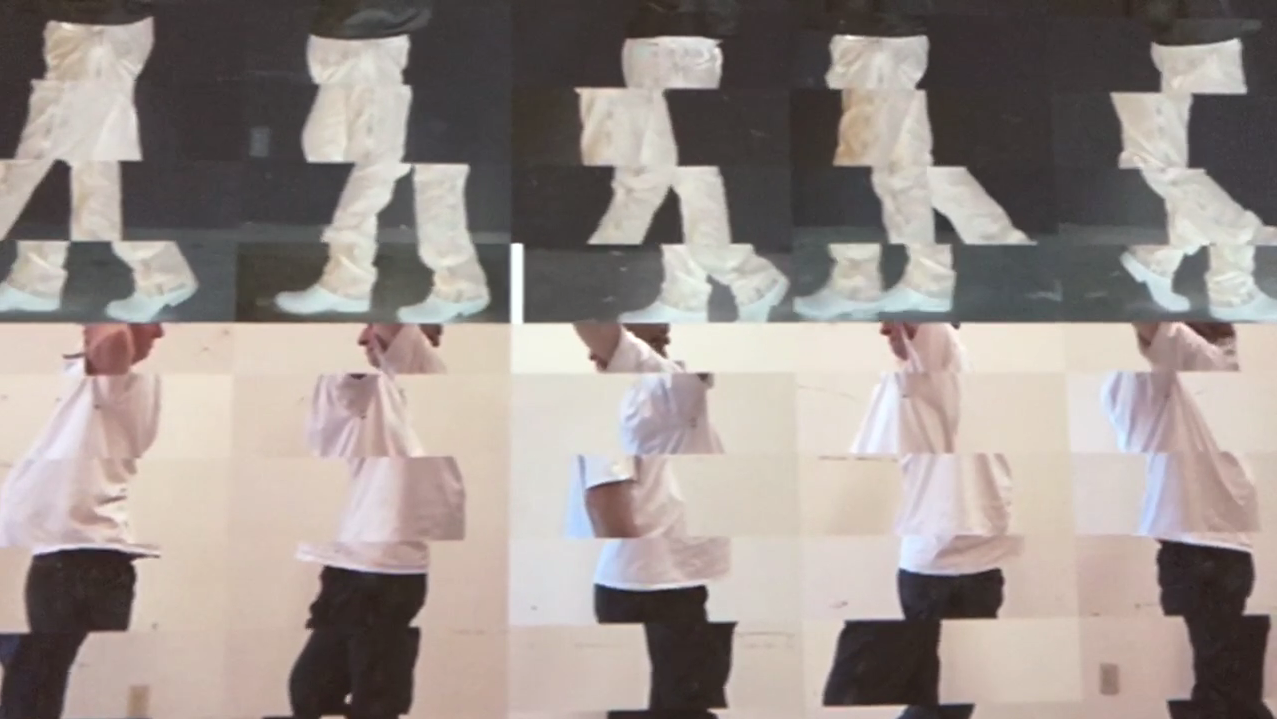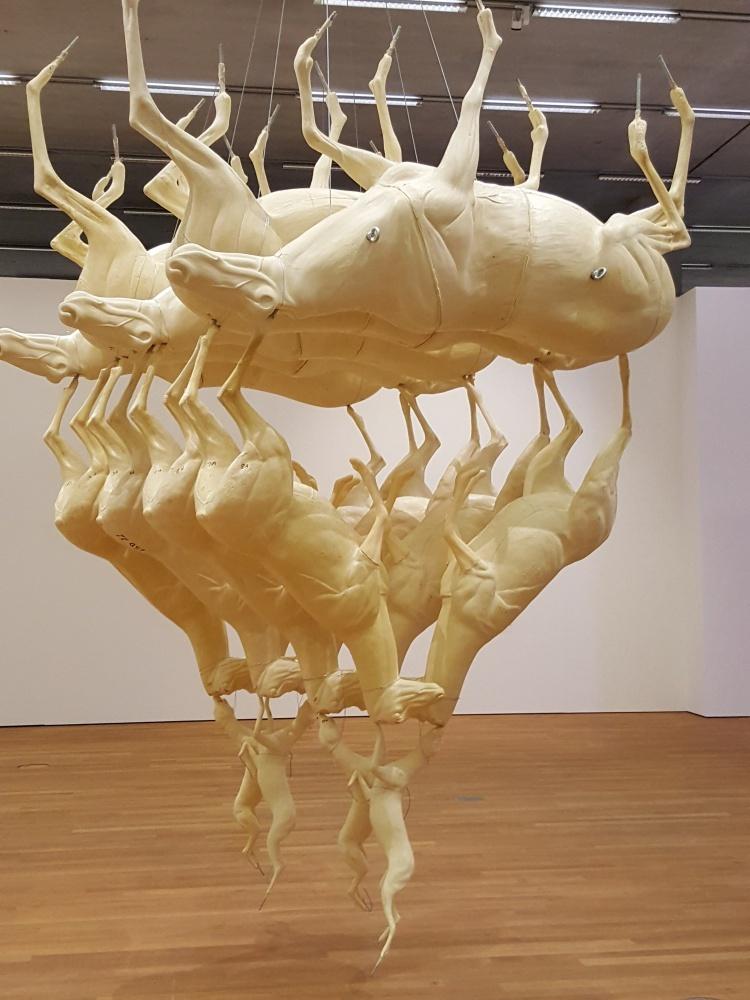The enigma explorations of Bruce Nauman at Schaulager

Dedicated to the American Bruce Nauman, the 2018 exhibition at Schaulager Basel celebrates the creativity of an elusive artist who for 50 years has explored art as an experiment. For five months, the ambitious Disappearing Acts retrospective runs alongside Art Basel and showcases works that trouble, amuse, shock and delight.
Since 2002, Schaulager BaselExternal link has staged some of the most enigmatic and powerful artists of our times and this year’s edition is no exception. Bruce Nauman is the Houdini of the art world and arguably one of America’s most respected contemporary artists. The aptly named Disappearing Acts retrospective in Basel does him justice as it seizes his constant state of flux.
Nauman has the tireless mind of a scientist who explores answers to questions that have not yet been asked, and proposes art works as both answers and new questions. It comes as no surprise that he first studied mathematics and physics, before turning his explorations into an artistic process.
Performance videos
And what better place to start exploring than one’s own body? Still in his twenties, Nauman entered the door of performance art, but not through public happenings, like those of Yoko Ono, Carolee Schneemann, Marina Abramovic or Chris Burden. Instead, he worked in the seclusion of his studio, filming the performances to secure them forever.

More
Contrapposto Nauman
His innovation was to use video as a tool for art. As early as 1968, Nauman was filming himself in various interrogations of body movements. Bouncing in the Corner, Walk with Contrapposto, Slow Angle Walk (Beckett Walk), all present at Schaulager, launched him and brought him to the attention of the legendary Swiss curator, Harald Szeemann. The following year, Nauman was invited to take part in When Attitudes Become Form at Kunsthalle Bern, a turning point in the perception of adventurous contemporary art.
Patronage by a Swiss foundation
By 1973, several Bruce Nauman drawings had entered the Emanuel Hoffman Foundation, created by Maja Hoffmann, the Swiss pharmaceutical heiress and grandmother of Maja Oeri, who founded Schaulager.
“Bruce Nauman has a unique place in our collection,” says Oeri. “He has been considered relevant for 45 years by the three successive chairwomen of our collection.”
Oeri had the idea for a Nauman retrospective as early as 1995 and has held on to it despite the obstacles: many of Nauman’s works are fragile and lenders were reluctant to part with them. There are 70 lenders for the 170 pieces in the exhibition.
“Very few artists constantly reinvent. Bruce is loyal to questions and ideas and is always looking for new and unexpected ways to express them. This is an opportunity for a new generation to experience his wonderful, brutal and touching works in their original form.”
Maja Oeri consistently makes startling choices, remaining in the vein of the Hoffman foundation’s credo: “The Foundation’s funds are to be used to purchase works by artists whose means of expression are forward-looking and not yet generally understood by their own time.”
It’s not that Bruce Nauman is not understood by his time – it’s just that it doesn’t appear to matter to him if he is or not. He comes to Schaulager after a string of other unmissable shows: Paul Chan, Steve McQueen, Tacita Dean, Francis Alÿs and Matthew Barney, equally undefinable artists, but perhaps hungrier for fame than Nauman is in the pursuit of their art.
An outsider artist
As we wander through the fluorescent austerity of Schaulager, we get the impression that the American artist, who lives in New Mexico, is only doing things for himself. There is little attempt at seduction, no formal need to remind us of aesthetic perceptions or the rules that govern the making of art. While his contemporaries Robert Rauschenberg and Jasper Johns scorned the post–Second World War art movement of abstract expressionism, of which they were part, Nauman did his own thing.
Optical illusions, sound experiments, neon catchphrases, contrapposto studies (the shifting weight of a body), screen tunnels, balance suspensions, prism effects – the list of explorations goes on forever.

He operates like an outsider artist, impermeable to the influences of his time. His interest in the physical and mechanical properties that rule our movements are, likewise, infused with the obsessive qualities that define outsider artists. He doesn’t betray himself any more that he can betray gravity; he simply plunges into whatever intrigues him.
Eternally youthful
Curator Kathy Halbreich, an associate director at the New York Museum of Modern ArtExternal link (MoMA) who now heads the Robert Rauschenberg FoundationExternal link, observes that Nauman’s latest works are as urgent and compelling as those of a 24-year-old.
“Few artists do consistently fine works over such a long period that foster such independent thinking,” she says. “He has a restless inventiveness that invites us to relinquish the familiar.”
There is an eerie intensity in everything Nauman does, as well as a dose of surrealist humour: for example, when a tape recorder spins a magnetic tape like an extended rubber band, or in Venice Fountains. There is also a disturbing fragility, a hanging on to nothingness, as in the exquisite drawings made in anticipation of a thought or a project – of which there are many in the exhibition. Even the massive works are in a state levity, many dangling from the ceiling, like his sculpture of leaping foxes and reindeers.
Art beyond art
There is also a beauty in Nauman’s artistic autism, one that appears to save him from the destructive forces of the ever-demanding art market. He may be one of the most successful artists of our times, but he hasn’t allowed that to get in the way. He gives us the extraordinary feeling that he has shared with us something that no one has ever done before, nor will again.
When Kathy Halbreich says that “Bruce makes art, not exhibitions,” we feel like asking, “What if he did neither?” Bruce Nauman has been walking on the tightrope of creative questioning for almost 77 years, and each one of his explorations is a disappearing act.
Bruce Nauman: Disappearing Acts
A large-scale retrospective of the US artist from his earliest works to his most recent installations runs until August 26, 2018 at Schaulager, Basel, before being presented at the Museum of Modern Art in New York in the autumn.

In compliance with the JTI standards
More: SWI swissinfo.ch certified by the Journalism Trust Initiative













You can find an overview of ongoing debates with our journalists here . Please join us!
If you want to start a conversation about a topic raised in this article or want to report factual errors, email us at english@swissinfo.ch.